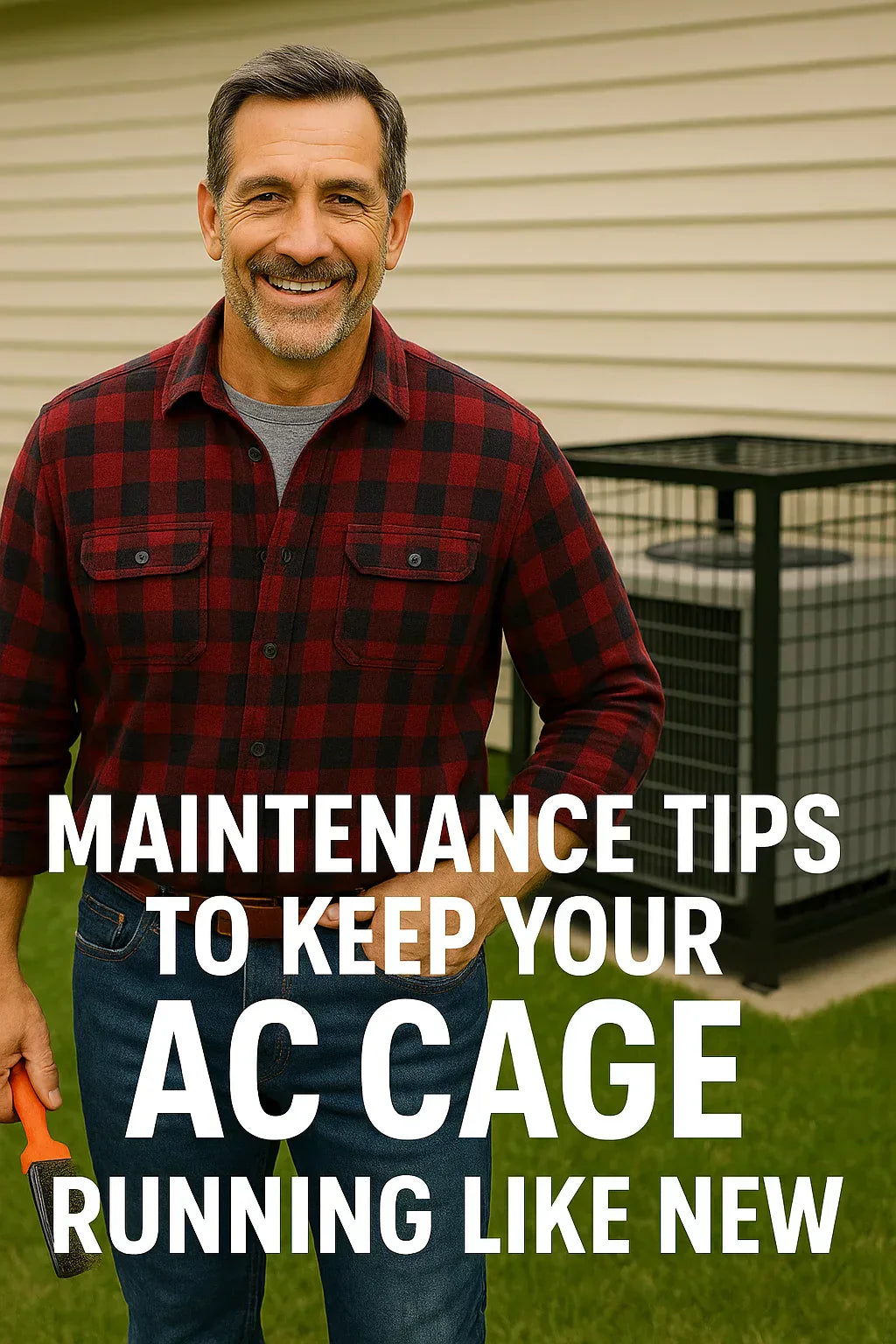🛡️ Why Maintaining Your AC Cage Matters
An AC cage like the T-Rex Air Conditioner Cage Model TREX3X3 protects your investment from theft, vandalism, storm debris, and animal interference. However, improper maintenance can lead to rust, seized locks, airflow blockages, and even structural weakening, reducing your HVAC efficiency and the cage's lifespan.
For practical homeowners like Mike Sanders, learning how to properly maintain your AC cage ensures long-term protection while keeping your system efficient and visually clean.
🗂️ What Causes AC Cage Deterioration?
✅ Weather Exposure: Rain, UV rays, snow, and coastal salt air contribute to corrosion.
✅ Debris Build-up: Leaves, grass, and dirt around the cage trap moisture.
✅ Physical Impact: Branches, hail, and objects hitting the cage can chip paint.
✅ Neglect: Skipping inspections or ignoring rust spots accelerates damage.
✅ Improper Installation: Cages installed without rust protection on anchor points deteriorate faster.
For corrosion prevention insights, see Rust-Oleum’s rust prevention guide.
🧹 Weekly Maintenance Checklist
✅ Visual Check: Look for rust spots, paint chips, or structural damage.
✅ Debris Clearance: Remove leaves, dirt, and grass clippings around the cage.
✅ Lock Check: Ensure locks are functioning and clear of debris.
✅ Airflow Check: Ensure nothing is blocking airflow around the unit.
For seasonal outdoor maintenance, see Family Handyman’s guide.
🧽 Monthly Deep Cleaning
1️⃣ Hose down the cage: Remove dust, pollen, and dirt.
2️⃣ Mild Soap Scrub: Use a sponge or brush to remove tougher grime.
3️⃣ Dry Thoroughly: Prevent water from pooling on or around the cage.
4️⃣ Inspect Locks: Lubricate using silicone spray or graphite lubricant.
5️⃣ Check Anchor Stability: Ensure bolts are tight and rust-free.
For HVAC cleaning best practices, see Energy.gov’s HVAC maintenance recommendations.
🛠️ Addressing Rust Immediately
✅ Rust Converter: Apply to small rust patches to stop further corrosion.
✅ Touch-Up Paint: Use outdoor, rust-resistant paint on chipped or treated areas.
✅ Protective Wax: Adds an extra barrier against moisture.
Tip: Addressing rust early prevents structural weakness and prolongs your cage’s life.
For outdoor painting guidance, see This Old House’s painting metal guide.
🔐 Lock and Hinge Maintenance
Locks and hinges are critical for security. To prevent seizing:
✅ Lubricate locks monthly with silicone spray.
✅ Keep locks covered or sheltered from direct rain.
✅ Clear debris from keyholes.
✅ Apply de-icer in winter to prevent freezing.
For lock maintenance in all seasons, see guide.
🌬️ Maintaining Airflow Around Your AC Cage
✅ Trim vegetation to maintain 12-24 inches clearance around the cage.
✅ Avoid placing objects near the unit that may block airflow.
✅ Check for and remove debris around the base regularly.
✅ Ensure the cage design (like T-Rex’s wide bar spacing) allows sufficient ventilation.
For airflow and efficiency tips, see Energy Star’s AC airflow guidelines.
🛡️ Seasonal Maintenance Guide
🌸 Spring:
-
Check for winter rust or anchor issues.
-
Lubricate locks and hinges.
-
Touch up paint as needed.
-
Clear any spring debris.
☀️ Summer:
-
Inspect for rust due to storms.
-
Maintain clear airflow for peak efficiency.
-
Ensure locks are functioning for vacation periods.
🍂 Fall:
-
Clear leaves and moisture-trapping debris.
-
Inspect anchors before winter freeze.
-
Lubricate locks before cold weather.
❄️ Winter:
-
Check for ice accumulation.
-
Apply de-icer to locks if necessary.
-
Monitor structural integrity during snow loads.
For HVAC seasonal coordination, see Carrier’s AC maintenance tips.
💡 Advanced Maintenance Tips
✅ Install Gutter Extensions: Prevent direct rain splash onto the unit.
✅ Apply Wax or Protective Coatings Annually: Extend powder coating lifespan.
✅ Record Maintenance: Keep a log for warranty and insurance claims.
✅ Inspect After Severe Storms: Look for damage, dislodged anchors, or debris entanglement.
For severe weather HVAC prep, see Energy.gov’s storm preparation guide.
⚠️ Common Maintenance Mistakes to Avoid
❌ Ignoring small rust spots until they spread.
❌ Overlooking airflow clearance when trimming vegetation.
❌ Forgetting to lubricate locks, causing them to seize.
❌ Using non-outdoor paint for touch-ups.
❌ Failing to check anchors seasonally.
🏡 Why Maintenance Impacts Efficiency
An unmaintained AC cage can lead to:
❌ Restricted airflow, increasing energy bills.
❌ Rust expansion, weakening cage security.
❌ Seized locks, hindering technician access.
❌ Visual deterioration, impacting property aesthetics.
Maintaining your AC cage preserves your HVAC system’s efficiency and protects your investment.
📈 ROI of Maintaining Your AC Cage
Regular maintenance:
✅ Avoids early replacement ($350 - $700 for a new cage).
✅ Prevents HVAC inefficiency ($100+ per year in energy waste).
✅ Reduces theft risk by maintaining visual deterrence.
✅ Extends lifespan of locks and anchors.
✅ Protects your HVAC system ($3,000 - $7,000 replacement cost).
❓ Frequently Asked Questions
How often should I clean my AC cage?
Monthly in heavy pollen seasons; quarterly otherwise.
Can I repaint my AC cage myself?
Yes, using outdoor, rust-resistant spray paint.
Will maintaining my cage reduce energy costs?
Yes, by preserving airflow.
How do I prevent locks from freezing?
Lubricate before winter and use lock covers.
Should I check my cage after storms?
Yes, to ensure anchors and structure are intact.
🏁 Final Checklist for AC Cage Maintenance
✅ Weekly visual checks.
✅ Monthly cleaning and lock lubrication.
✅ Seasonal anchor and rust inspection.
✅ Airflow clearance checks.
✅ Prompt rust treatment.
✅ Touch-up painting annually.
✅ Record maintenance activities.
In the next topic we will know more about: Is an AC Cage Worth It? Pros, Cons & Real-World ROI







